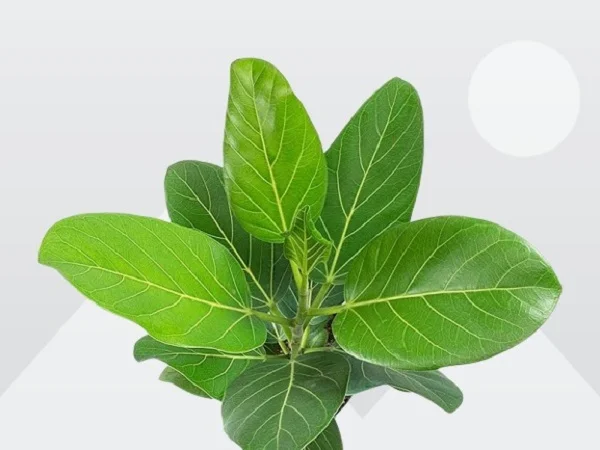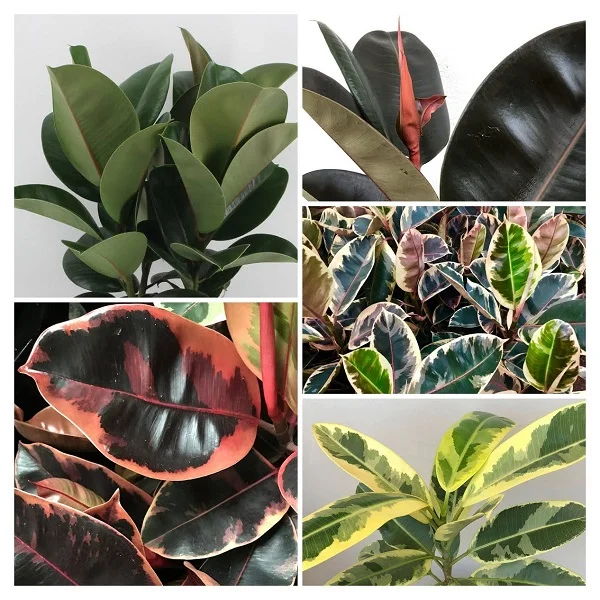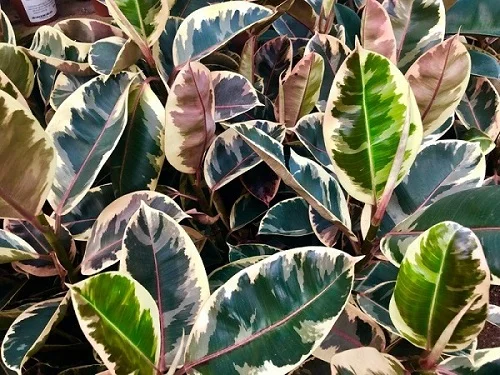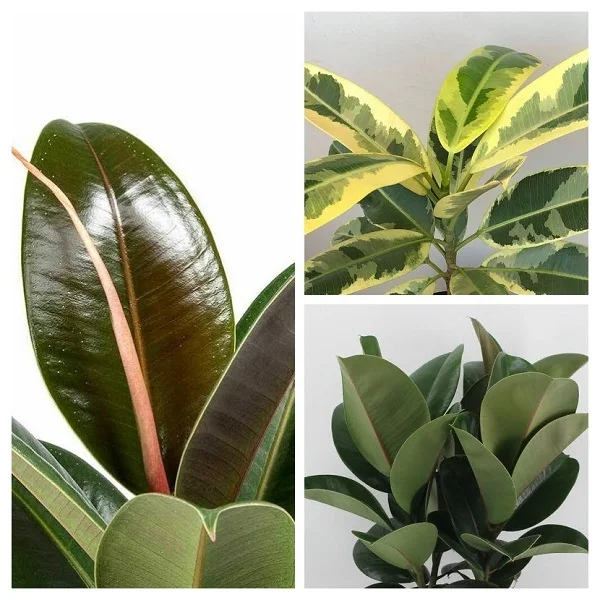How Do You Care for Ficus benghalensis 'Audrey' Indoors
Some links in this post may be affiliate links
Ficus benghalensis 'Audrey' does well in bright light with some morning or late afternoon sunlight, average warmth, moderate humidity and moderately moist, rich, well-drained soil coupled with monthly feeding in the growing season.
In this guide, we will break down everything you need to know about Ficus Audrey care indoors; from the perfect light and watering schedule to pruning, repotting, and troubleshooting common plant problems. But first, let's delve into some facts about this plant.
Ficus benghalensis 'Audrey' also called Ficus Audrey, Bengal Fig, Banyan Fig, Banyan Tree, Indian Banyan or Strangler Fig is among the fast-growing Ficus varieties. It bears green, oval leaves with a fuzzy surface and a smooth light-colored trunk.
Bengal Fig has a high tolerance to drought and frosty conditions. It is considered much easier to grow indoors than its cousin Ficus lyrata (Fiddle Leaf Fig).
Indian Banyan is the National Tree of India where it is considered sacred as it is believed that Buddha received enlightment while under this tree.
Temples are often built near a Banyan Tree and it also provides shade in hot climates. The tree can grow very huge in its natural habitat.

Botanical name: Ficus benghalensis 'Audrey'
Family: Moraceae
Common names: Ficus Audrey, Bengal Fig, Banyan Fig, Banyan Tree, Indian Banyan, Strangler Fig
Origin
Ficus benghalensis 'Audrey' is native to the Indian Subcontinent in India, Sri Lanka and Pakistan where it grows as an epiphyte on trees but ends up suffocating its host hence the common name, 'Strangler Fig'.
Size
Banyan Fig can grow to a height of 65-100 feet and can fill acres of land in width in its native habitat. Indoors the growth can be controlled by pruning to 5-10 feet high and 3-4 feet wide. It is one of the best tree-like plants for the home.
Toxicity
Ficus benghalensis 'Audrey' is toxic to humans and pets as outlined by Pet Poison Helpline. The plant produces a milky white latex which is an irritant to the eyes and the skin. If ingested it can cause irritation in the mouth, drooling, vomiting, diarrhea, loss of appetite and abdominal pains.
Where to Buy
Are you looking to add Ficus Audrey to your plant collection? They are available online on Etsy (Link to Etsy) and on Amazon (Link to Amazon).
Caring for Ficus benghalensis 'Audrey' Indoors
Let’s dive into how to keep your Ficus Audrey happy and thriving indoors. Ficus benghalensis 'Audrey' flourishes in bright light with 4-6 hours of morning or late afternoon sunshine, average warmth of 16-260C, moderate humidity of 50-55% and moderately moist, rich, well-drained, potting soil coupled with monthly feeding during the growing season.
Bengal Fig requires regular pruning to keep it neat, reduce pests and diseases and also encourage a bushy growth. Repotting is only needed when it becomes pot-bound. Keep reading for more on these growing conditions and how to achieve them.

Watering
Water your Ficus Audrey liberally during the growing season until water comes out through the drainage holes. Allow the top 2-3 inches of soil to dry out between waterings. Keep the soil moderately moist and avoid overwatering to prevent yellowing leaves.
Cut down on watering in the cold season to maintain the soil barely moist as growth is reduced at this time. However, do not allow the soil to dry out completely as it can result in wilting and drooping leaves.
Ensure that the pot has a drainage hole to prevent the soil from getting soggy as it can lead to leaf drop and root-rot and death of the plant.
Use tepid (room temperature water). Make sure that the water is chlorine-free to avoid getting brown spots on the leaves. Learn more on how to water indoor plants correctly.
Light Requirements
Ficus Audrey grows best in bright light with 4-6 hours of morning or late afternoon direct sunlight. Keep it away from hot direct sunlight to prevent scorching; brown, crispy spots on the leaves.
Bengal Fig can adapt to lower light conditions but it will grow much slower and too little light may cause yellowing and leaf drop. If the natural lighting is too low, you may invest in a full spectrum grow light.
For uniform growth and avoid leggy growth, turn the pot regularly to ensure that the plant receives light on all sides.
Temperature and Humidity
Ficus Audrey thrives in average warmth of 16-260C. Keep it away from drafts to prevent temperature flactuations as they can lead to stunted growth and leaf drop.
Moderate humidity of 50-55% is ideal for Ficus Audrey. However, if the air is too dry, set the pot on a wet pebble tray or use a cool mist humidifier to elevate humidity. Ensure there is good airflow to minimize fungal diseases.
Fertilizer
Feed your Ficus Audrey monthly during the growing period (spring and summer.) with a balanced, water-soluble fertilizer for a lush growth. Do not feed in the cold season (fall and winter) as growth is minimal and feeding at this time can lead to fertilizer burn resulting in brown leaf tips and edges.
Ficus Audrey Soil
The best Ficus Audrey soil should be a well-draining, nutrient-rich soil; one that retains some moisture but drains quickly. A mix made up of 2 parts potting soil, 1 part perlite (for aeration) and 1 part coconut coir or peat moss (for moisture retention) is ideal.
Repotting
Repot your Ficus Audrey at the beginning of the growing season only when it has become pot-bound. Usually, repotting every 2-3 years is adequate for this plant.
Avoid frequent repotting as it prefers to be pot-bound. Repot only when it has outgrown its current pot; when roots begin to grow through the drainage holes.
Use a pot 1-2 size larger and one that has a drainage hole to prevent the soil from getting soggy. Never allow the roots to sit in soggy soil as it may lead to leaf drop and root-rot.
For a large Bengal Fig which may be difficult to handle, annually replenish the top 2-4 inches of soil with fresh soil. Check out these pots with drainage holes on Amazon.
Pruning & Grooming
Pruning Ficus Audrey is easy. Remove dead and yellow leaves to maintain the plant neat and minimize pest and disease infestations.
When Bengal Fig has reached the maximum desired height or it has become leggy, cutback the branches to rejuvenate growth and encourage a bushy, compact growth. The foliage emanating from the pruning can be used to propagate new plants.
Occasionally clean the leaves by damp-wiping with a soft cloth to get rid of dust and discourage pest and disease infestations.
Ficus Audrey Propagation
Ficus Audrey propagation can be done by air layering or from stem cuttings. The best time to propagate is during the growing season (spring and summer) when the plant is actively growing as it enhances establishment.
Read more on How to Propagate Ficus Audrey in 3 Easy Ways.

Ficus benghalensis 'Audrey' Problems
Ficus Audrey problems include leaf drop, drooping leaves, yellow leaves, brown leaf tips, pests and diseases among others. Keep reading for more on these problems and how to solve them.
Leaf drop (loss)
Leaf drop (loss) in Ficus Audrey is due to sudden changes in the growing conditions, underwatering, low light, temperature stress, being pot-bound, fertlizer burn.
- Sudden changes in the growing conditions: This may happen when you bring the plant home or when you move it to a new location in the home. Always place the in bright light with some sunshine and average warmth. Avoid making too many changes at once.
- Underwatering: Water when the top 2-3 inches of soil dry out but do not allow the soil to dry out completely.
- Low light: Move the plant to a brighter spot where it will receive bright light with 4-6 hours of sunshine or instal a grow light if the natural lighting is not enough.
- Temperature stress: Keep the plant away from drafts emating from AC units, stoves, windy doors, drafty windows among others and maintain an average warmth of 16-260C.
- Being pot-bound: Check for roots growing through the drainage hole. Repot the plant into a pot one size larger than the current one.
- Fertlizer burn: Avoid too much fertilizer by following the recommendations on the label. Do not feed in the cold period (fall and winter).
Related: 14 reasons why Rubber Plant is dropping leaves and how to fix them
Drooping leaves
Drooping leaves in Ficus Audrey are due to incorrect watering, high temperatures, pests and age (maturity).
- Incorrect watering: Either underwatering or overwatering. Water the top 2-3 inches of soil to dry out. Reduce watering in the cold season but do not allow the soil to dry out completely.
- High temperatures: Keep the plant from hot drafts from heat sources, stoves and others to maintain average warmth.
- Pests infestations: Insects like spidermites and scales will suck the plant causing dehydration, wilting and drooping. Inspect your plant regularly and carry out timely control measures.
- Age: With maturity, the lower leaves drop leaving a bare stem with a crown of leaves at the top. Cutback the stem at the desired height and new growth should sprout just below the cut into a new bushy plant.
Related: 13 Reasons Why Rubber Plant Leaves are Drooping & How to Fix Them
Brown leaf tips and edges
Brown leaf tips and edges in Ficus Audrey are caused by too low humidity. Set the pot on a wet pebble tray or use a cool mist humidifier to raise humidity.
Yellow leaves
Yellow leaves in Ficus Audrey are due to overwatering and poor soil drainage. Let the soil dry out slightly before watering again and make sure the soil is well-draining and the pot has a drainage hole.
Yellow leaf edges
Yellowing leaf edges in Ficus Audrey are caused by underfeeding. To promote a healthy growth, feed the plant with a balanced, water-soluble fertilizer monthly during the growing period only.
Pests
The common pests in Ficus Audrey are scale insects, aphids, mealybugs and spider mites. Isolate the affected plant to prevent spread to other plants and treat with neem oil as directed by the manufacturer. Keep the plant properly pruned at all times to reduce the breeding places for these pests.
Diseases
Ficus Audrey is prone to root-rot disease which is enhanced by soggy soil. Make sure that there is free drainage of both the soil and the pot and also reduce watering during the cold season.
Conclusion
Ficus benghalensis 'Audrey' is a beautiful, low-maintenance indoor tree that is perfect for plant lovers looking for a less fussy alternative to the Fiddle Leaf Fig. With proper light, watering, and occasional pruning, it will thrive for years and bring a touch of the tropics to your space.
You liked it? Share on social media.
Related Content
Amazon Associates Disclosure
Homeplantsguide.com is a participant in the Amazon Services LLC Associates Program, an affiliate advertising program designed to provide a means for sites to earn advertising fees by advertising and linking to amazon.com.





